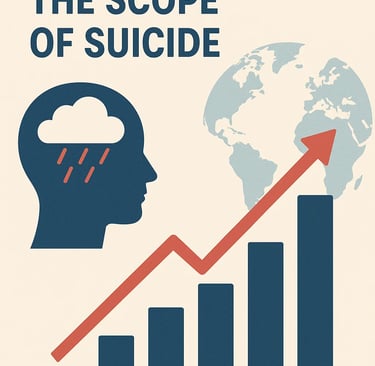Suicide Prevention Month: Perspective on Hope, Healing, and Support
While September is recognized as Suicide Prevention Month, the importance of raising awareness, reducing stigma, and encouraging open conversations about mental health does not end with the month. Suicide prevention is something that should remain at the forefront of our minds throughout the year. As mental health professionals, we understand that suicide is not simply an individual tragedy, it is a public health issue that affects families, workplaces, and communities across all demographics. Suicide is complex, often stemming from a combination of emotional pain, trauma, mental illness, substance use, and life stressors. Yet, it is also preventable. Through early intervention, accessible care, and compassionate support, lives can be saved. Let’s continue these conversations beyond September and work together to create a culture of awareness, connection, and hope, every single day.
All In Health
10/2/20254 min read


Understanding the Scope of Suicide
According to data from the Centers for Disease Control and Prevention (CDC) and the National Institute of Mental Health (NIMH), suicide continues to be a leading cause of death in the United States, affecting individuals of all ages and backgrounds.
In 2023, over 49,000 Americans died by suicide, with rates among men nearly four times higher than among women.
Suicide is the second-leading cause of death among individuals aged 10–34 and the fifth-leading cause among those aged 35–54.
Rates have increased among young adults (ages 15–24) and middle-aged adults (35–44) in recent years.
Certain populations face even higher risks, including veterans, LGBTQ+ youth, Indigenous communities, and individuals with a history of trauma or substance use disorders.
Behind these numbers are real people, mothers, fathers, friends, and children. Each with a story that could have changed with timely support and connection.
The Link Between Mental Health, Trauma, and Addiction
Mental health and suicide are deeply intertwined. Conditions such as depression, anxiety, post-traumatic stress disorder (PTSD), and substance use disorders are among the strongest predictors of suicidal ideation and behavior. For many, suicidal thoughts are not about a desire to die, but rather a desperate wish for emotional pain to end.
Unresolved trauma and chronic stress alter brain chemistry, impairing emotional regulation and increasing vulnerability to both addiction and suicidal thinking. Substance use can temporarily numb distress but often deepens depression and impulsivity, especially during withdrawal or emotional lows. Recognizing and addressing these connections through integrated care is critical to suicide prevention.


The Role of Professional Treatment in Suicide Prevention
Suicide prevention requires a multi-layered approach. One that includes education, early intervention, access to care, and consistent follow-up. Mental health treatment is one of the most effective tools we have for preventing suicide and supporting those at risk.
Individual Therapy
Individual therapy provides a confidential, safe space for clients to explore the underlying causes of their distress. Evidence-based approaches such as Cognitive Behavioral Therapy (CBT), Dialectical Behavior Therapy (DBT), and Trauma-Informed Therapy, help clients identify unhelpful thought patterns, regulate emotions, and develop coping strategies to manage suicidal ideation.
Therapy also focuses on safety planning, which involves identifying warning signs, coping mechanisms, and emergency contacts. These individualized plans help clients regain a sense of control and safety during times of crisis.
Group Therapy
Group therapy and support groups offer something unique: connection. Many people experiencing suicidal thoughts feel isolated or misunderstood. Group settings create a sense of belonging and understanding that can reduce shame and loneliness. Participants learn from one another’s experiences and gain hope from peers who are further along in recovery.
In addition to emotional support, group sessions help develop communication skills, problem-solving techniques, and a greater sense of accountability, all of which are protective factors against suicide.
Coaching and Recovery Support
Mental health and recovery coaching complement therapy by offering structure, motivation, and practical tools for day-to-day wellness. Coaching focuses on setting achievable goals, maintaining routines, and staying engaged in recovery work.
For individuals at risk, consistent coaching check-ins can help monitor mood, reinforce coping strategies, and encourage help-seeking behaviors before a crisis escalates. Coaching bridges the gap between therapy sessions and real-life application, supporting long-term stability and growth.
The Importance of Early Intervention
Suicide prevention starts long before a crisis occurs. Early intervention and routine mental health check-ins are vital. When we normalize conversations around emotional distress and make mental health support accessible, we reduce the likelihood of escalation.
Preventive care may include:
Regular mental health screenings in primary care or community settings
Education on recognizing signs of distress (withdrawal, hopelessness, agitation, or talk of death)
Encouraging individuals to seek professional help early before symptoms become overwhelming
Integrating trauma-informed and substance use recovery services to address the full spectrum of mental health needs
Prevention is not only about saving lives, it’s about improving quality of life and building resilience.


How All in Health Can Help
We are committed to providing compassionate, evidence-based care to individuals struggling with depression, anxiety, trauma, or suicidal thoughts. Our integrated services include:
Individual Therapy: Personalized sessions that focus on safety, healing, and coping skill development.
Group Therapy: Supportive environments where clients can connect, share, and learn from others’ experiences.
Coaching and Individualized Recovery Support: Practical, strengths-based guidance for maintaining structure, accountability, and emotional regulation between therapy sessions.
We approach every client with respect, empathy, and a belief in their ability to heal. Our goal is not just to reduce symptoms but to help each person rediscover hope, purpose, and connection.
Resources and Support
If you or someone you know is struggling with suicidal thoughts, help is available 24/7:
988 Suicide and Crisis Lifeline: Call or text 988 (U.S.)
Crisis Text Line: Text HOME to 741741
The Trevor Project: For LGBTQ+ youth — Call 1-866-488-7386 or text START to 678678
Veterans Crisis Line: Call 988, then press 1
National Alliance on Mental Illness (NAMI) Helpline: 1-800-950-NAMI (6264)
For ongoing therapy, group, or coaching support, reach out to All in Health. Whether you are in crisis, in recovery, or seeking preventative support, you do not have to face this alone.
Suicide Prevention Month reminds us that every conversation about mental health matters. When we open the door to talk about pain, loss, and hopelessness, we also open the door to healing. Every act of empathy, every moment of connection, and every treatment session has the potential to save a life.
We believe in recovery, in resilience, and in the power of support. Together, we can make a difference one conversation, one session, one life at a time.
GET STARTED TODAY
Your journey. Our commitment. Together, we’re all in.
STAY IN TOUCH
Contact Us
954-445-1567
© 2024. All rights reserved.
